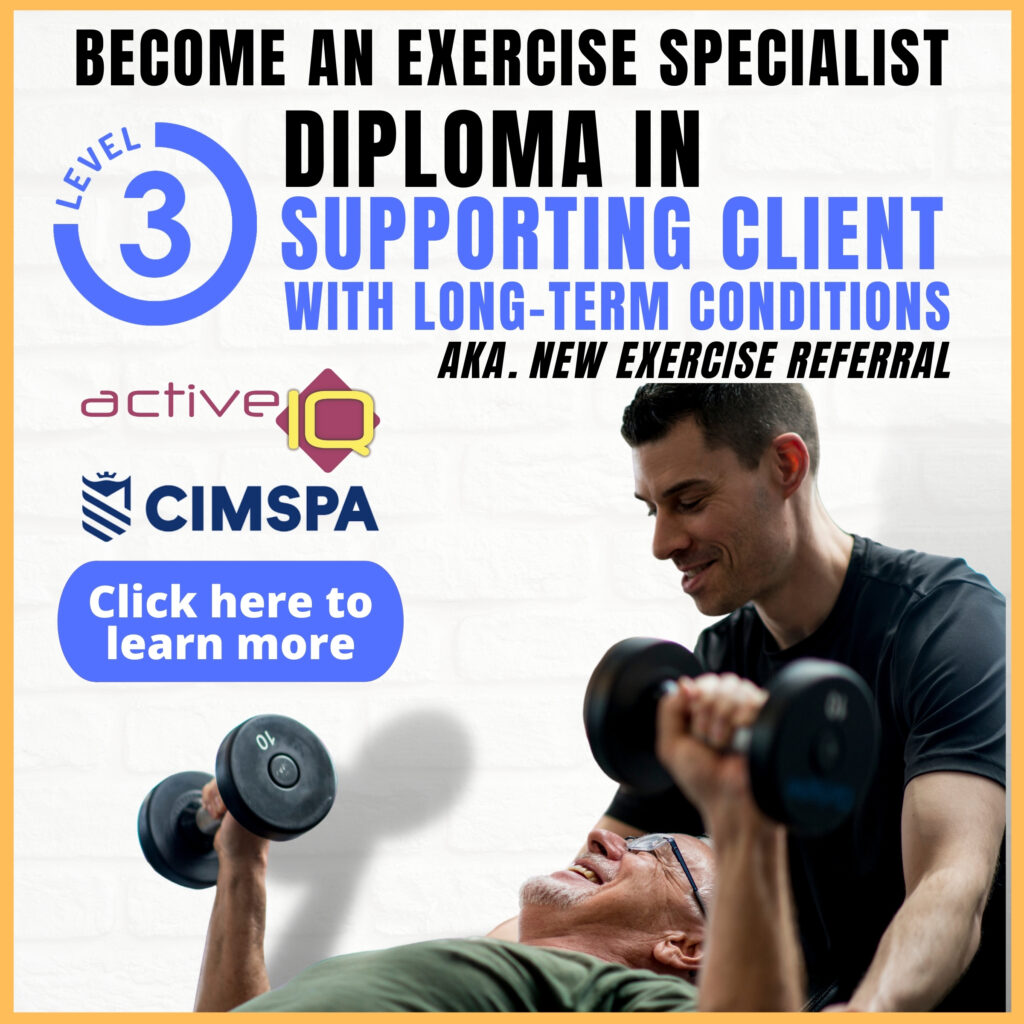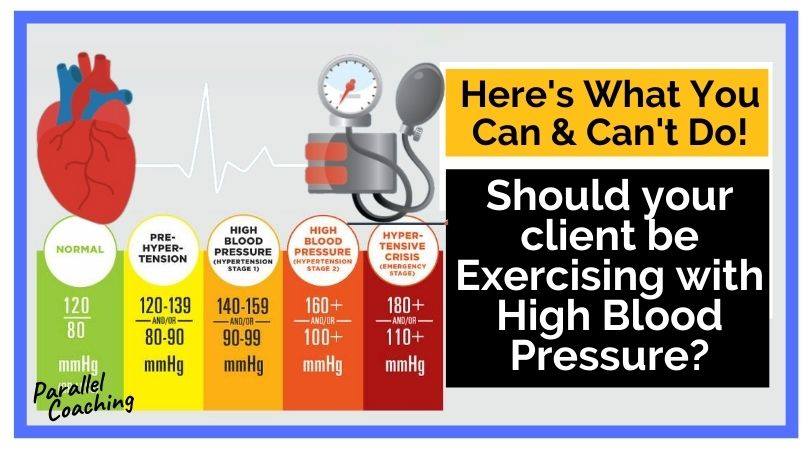In this blog, we’ll clarify whether exercising with high blood pressure is safe and how to know who you can work with as a Fitness Professional.
You’ll Discover:
- What is High Blood Pressure and classifications?
- How hypertension is treated and managed
- The dangers of Exercising with High Blood Pressure
- How to manage the risks and which exercises to avoid
WARNING: Are you qualified?
Before we start to learn the ins and out of training a client with hypertension it is important that you are adequately qualified as a fitness professional. A client with High blood pressure/ hypertension refers a PARQ and is at higher risk of heart attack or stroke on the session.
As a Level 2 and 3 fitness instructor, it is unlikely your qualification included the knowledge of how to train a hypertensive client and learn how to manage these risks.
Without a Specialist Qualification or equivalent, you cannot prescribe exercise to clients with high blood pressure. These specialist qualifications include the Diploma in Exercise Referral or the New Level 3 Diploma in Supporting Clients With Long Term Conditions.
What is high Blood Pressure?
Blood pressure (BP) is the pressure the blood exerts on the artery walls. The pressure increases when the heart contracts and decreases as the heart relaxes.
Blood pressure is recorded as systolic blood pressure (SBP) over diastolic blood pressure (DSP) and is measured in millimetres of mercury (mmHg); optimal BP is 120/80mmHg.
Systolic blood pressure is the pressure exerted during the contraction of the heart and diastolic blood pressure is when the heart relaxes.
High blood pressure (hypertension) will be diagnosed if BP is consistently above 140/90mmHg.
What is essential hypertension?
When there is no clear cause of hypertension it is called ‘Essential Hypertension’. This is the most common type of hypertension and is linked to genetics and a number of lifestyle factors such as obesity, smoking and alcohol.
What is secondary hypertension?
If hypertension is a result of an underlying cause, such as kidney disordered or thyroid problems, it is called secondary hypertension.
Blood Pressure can be affected by a number of factors such as stress levels, time of day, caffeine intake, and exercise amongst many more; therefore it’s important to measure and monitor blood pressure readings regularly, and before activity.
Classification of Blood Pressure
| Blood Pressure Classification | Systolic | Diastolic |
| Optimum | 120 | 80 |
| Normal Blood Pressure | <139 | <89 |
| Mild hypertensive | 140-159 | 90-99 |
| Moderately hypertensive | 160-179 | 100-109 |
| Severe hypertensive | >180 | >110 |
What does hypertension lead to?
Hypertension affects the structure and function of the blood vessels and if not managed effectively it can lead to a number of complications including:
- Heart failure
- Stroke / TIA
- Peripheral heart disease
- Kidney failure
- Angina
These complications can be accelerated by a number of factors such as co-morbidities (obesity and diabetes), high salt diet, inactivity and finally some non-modifiable factors such as family history, gender and ethnicity.
Medications for High Blood Pressure
The main aim is to manage hypertension through appropriate medication therapy and lifestyle modification.
Medication therapy has an important role in reducing high blood pressure and is usually started for individuals who have a blood pressure of 160/100mmHg or above after making lifestyle modifications or 140/90mmHg if the individual has a co-morbidity such as diabetes.
There are numerous medications that an individual may be prescribed, it is crucial that fitness professionals are suitably qualified within Exercise Referral to truly understand the exercise implication and medication side effects alongside the response to exercise.
Lifestyle advice for High blood pressure
As a fitness professional, you can offer clear guidance in line with best practice procedures outlined by NICE, 2011.
It is reported that making small lifestyle changes within activity and the daily diet can lower blood pressure by at least 10mmHg.
These could include:
- reducing and/or cutting out energy-dense drinks, caffeinated drinks
- less than 5 cups of coffee per day
- reduce saturated fats
- limit salt intake
- reduce/stop smoking and alcohol intake
- stress management
- relaxation approaches i.e. yoga
- and becoming more active
- many more.
Becoming more active is an important lifestyle factor in the prevention and management of hypertension.
Exercise has been heavily reported to reduce blood pressure long term alongside the prevention of obesity, reducing insulin resistance and increasing the capillary density of the muscle, therefore, contributing to a reduction in blood pressure.
Learn how to work with hypertensive clients in the New Level 3 Diploma in Supporting Clients With Long Term Conditions.
Guidelines for Exercise
Moderate-intensity cardiovascular exercise is recommended as the primary form of training for high blood pressure.
The exercise session should be tailored to the overall needs of the individual, taking into account:
- age
- co-morbidities
- fitness level
- current physical activity
- skill level
- confidence
- preferences
- lifestyle
- personal goals
Exercising with High Blood Pressure
Ensure that if your client has high blood pressure (over 140/90) they see their GP and is on appropriate medication before beginning an exercise program. You will also need to be adequately qualified in Exercise Referral or equivalent to work with the client.
Further still, consider any other co-morbidities to ensure a safe and effective intervention is undertaken.
Do not exercise if:
- resting blood pressure is >180/100mmHg on the day of exercise
- blood pressure significantly drops during exercise, and feeling light headed or dizzy
- the client is experiencing chest pains
- some medications impair the body to regulate temperature; therefore, avoid exercising in hot and humid conditions
- do not exercise if they are not feeling well or have a fever. Wait a few days after all symptoms disappear before starting your exercise program
Avoid These Exercises:
- discourage high-intensity aerobic training
- avoid the valsalva manoeuvre and encourage a steady breathing technique
- discourage any isometric activity such as gripping equipment tightly, plank position or a slow tempo
- avoid heavy resistance training – focus on light weights, high reps
- avoid any sustained upper body high intensity activity due to the increased myocardial workload
- avoid excessive overhead arm movements
Considerations:
- ADAPT: if the client is too tired and are not sure if it is related to overexertion, ask, “What did you do yesterday?” Try to change the activities by starting out at a lower level today (but do not exercise if they are feeling very overtired). Manipulate the session pace and balance activities with rest.
- KEEP THE INTENSITY LOW: do not go up steep hills during exercise, whenever possible. If you must walk on a hilly area, slow the walking pace down when going uphill to avoid working too hard.
- REGRESS: reduce activity level if the exercise program has been interrupted for a few days (for example, due to illness, work, holiday, or bad weather). Then, gradually increase back to their regular activity level as tolerated.
- REST: if they are short of breath during any activity or have increased fatigue, slow down, or rest. If they continue to have shortness of breath, call their GP who may make changes in their medications, diet, or fluid restrictions accordingly.
- CHECK FOR ABNORMALITIES: if they develop a rapid or irregular heartbeat or have heart palpitations, rest immediately.
Exercise Warning
Ensure to STOP exercising and rest if you have any of the following symptoms:
- Pain; do not ignore pain. If they have chest pain or pain anywhere else in your body, do not continue the activity. If they perform an activity while in pain, you may be doing more harm than good
- Chest pain
- Weakness Dizziness or lightheadedness
- Unexplained weight gain or swelling
- Pressure or pain in their chest, neck, arm, jaw, or shoulder or any other symptoms that cause concern.
- Call their GP or seek emergency treatment immediately if these symptoms do not go away quickly, or if such symptoms continue to recur.
Want to help more clients and become a specialist exercise referral instructor?
Want to become a specialist and train clients with Long Term Conditions?
Become a specialist in offering health-related activity advice and supporting clients that fail a PAR-Q or have Long Term Conditions.
This is your opportunity to set yourself apart from other FITPROs, expand your knowledge, confidence, and link up with healthcare professionals.

Dedicated to More
Hayley “Exercising with High Blood Pressure” Bergman
Parallel Coaching
P.S. You can also find us on the following platforms:
Instagram: Follow Now
Facebook: Like Our Page
Twitter: Tweet Us
YouTube: Subscribe Here
More Long-Term Conditions Blogs: HERE

